
Dendrobium is a genus of mostly epiphytic and lithophytic orchids in the family Orchidaceae. It is a very large genus, containing more than 1,800 species that are found in diverse habitats throughout much of south, east and southeast Asia, including China, Japan, India, the Philippines, Indonesia, Australia, New Guinea, Vietnam and many of the islands of the Pacific. Orchids in this genus have roots that creep over the surface of trees or rocks, rarely having their roots in soil. Up to six leaves develop in a tuft at the tip of a shoot and from one to a large number of flowers are arranged along an unbranched flowering stem. Several attempts have been made to separate Dendrobium into smaller genera, but most have not been accepted by the World Checklist of Selected Plant Families.
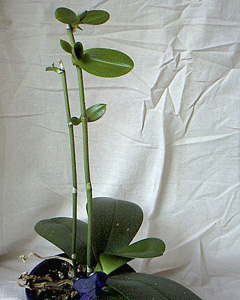
In horticulture, a keiki is a plant produced asexually by an orchid plant, especially Dendrobium, Epidendrum, and Phalaenopsis orchids. The baby plant is an exact clone of the mother plant, sometimes flowering while still attached to the mother. The word keiki is Hawaiian for 'baby' or 'child', literally meaning 'the little one'.
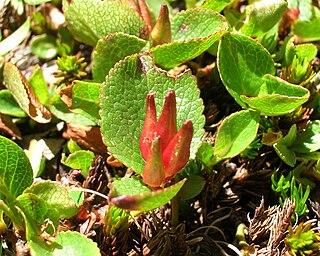
Salix herbacea, the dwarf willow, least willow or snowbed willow, is a species of tiny creeping willow adapted to survive in harsh arctic and subarctic environments. Distributed widely in alpine and arctic environments around the North Atlantic Ocean, it is one of the smallest woody plants.

Johannes Jacobus Smith was a Dutch botanist who, between years 1905 to 1924, crossed the islands of the Dutch East Indies, collecting specimens of plants and describing and cataloguing the flora of these islands. The standard botanical author abbreviation J.J.Sm. is applied to plants described by J.J. Smith.

Dendrobium speciosum, commonly known as the rock orchid or cane orchid, is a species of highly variable Australian orchid. Its varieties can be found in a range of habitats as epiphytes or lithophytes. It has a continuous distribution along the east coast of Australia and in distinct populations along the Tropic of Capricorn. As a lithophyte, it forms gigantic spreading colonies on rocks and cliff faces, often exposed to full sun, with its roots forming dense, matted beds across the rock that anchor the plant. It can be found at altitudes from sea level to 900 metres (3,000 ft).

Dendrobium nobile, commonly known as the noble dendrobium, is a member of the family Orchidaceae. Dendrobium nobile is one of the most widespread ornamental members of the orchid family. It is the state flower of Sikkim.

Dendrobium teretifolium, commonly known as the thin pencil orchid, rat's tail orchid or bridal veil orchid, is an epiphytic or lithophytic orchid in the family Orchidaceae. It has long, thin hanging stems, pencil-like leaves and rigid flowering stems bearing up to twelve crowded white to cream-coloured flowers. It grows in rainforest and humid open forest mostly in near-coastal districts in New South Wales and Queensland.
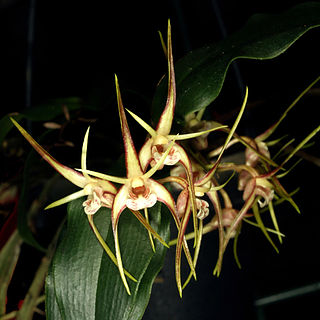
Dendrobium tetragonum, commonly known as the tree spider orchid, is a variable species of epiphytic or lithophytic orchid endemic to eastern Australia. Tree spider orchids are unusual in having pendulous pseudobulbs that are thin and wiry near the base then expand into a fleshy, four-sided upper section before tapering at the tip. There are only a few thin but leathery leaves at the end of the pseudobulbs and up to five flowers on relatively short flowering stems. To allow for the variations in the species there are five subspecies and a variety, some with a unique common name.
Dendrobium nativitatis, commonly known as the Christmas Island crimp orchid, is a species of epiphytic orchid that is endemic to Christmas Island, an Australian territory in the north-eastern Indian Ocean. It has long, straggly stems, flattened pseudobulbs, a single leathery leaf and a single pale yellow flower.
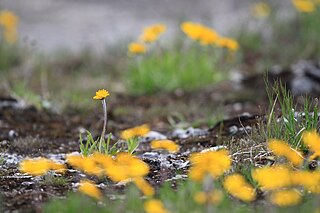
Tetraneuris herbacea is a rare species of flowering plant in the aster family known by the common names eastern fournerved daisy, lakeside daisy, fournerved starflower, and Manitoulin gold. It is native to and endemic to the Great Lakes region in North America, where it is present in Ontario, Ohio, Michigan, and Illinois. It is threatened by habitat destruction and degradation by several forces, including limestone quarrying, recreational activity, fire suppression, and construction. It is a federally listed threatened species of the United States and of Canada.
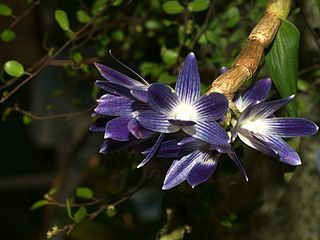
Dendrobium victoriae-reginae is a member of the family Orchidaceae endemic to the Philippines.

Dendrobium uniflorum is a species of flowering plant in the family Orchidaceae. It is native to the Malesia and Southeast Asia regions, in Thailand, Vietnam, Malaysia, Philippines, Borneo, Sulawesi, Sumatra.
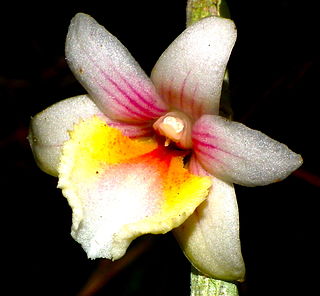
Dendrobium boosii, or Ronny Boos' dendrobium, is a species of plant in the family Orchidaceae endemic to the Philippines.

Dendrobieae is a tribe in the subfamily Epidendroideae, in the family Orchidaceae. The Dendrobieae are mostly tropical, epiphytic orchids which contain pseudobulbs.

Dendrobium section Dendrocoryne is a subgenus of orchids in the genus Dendrobium.
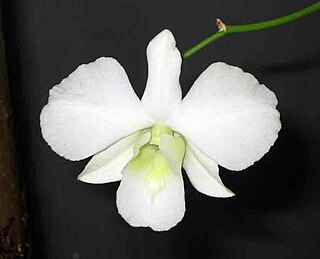
Dendrobium section Phalaenanthe is a section of the genus Dendrobium.

Dendrobium section Calyptrochilus is a section of the genus Dendrobium.

Dendrobium section Dendrobium is a section of the genus Dendrobium.
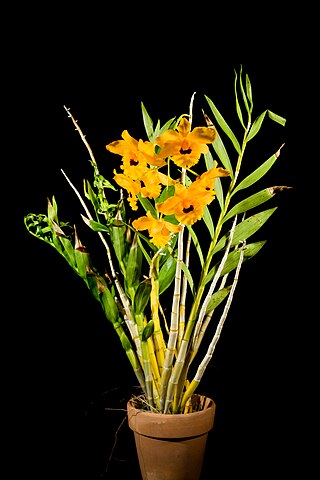
Dendrobium section Holochrysa is a section of the genus Dendrobium.





















